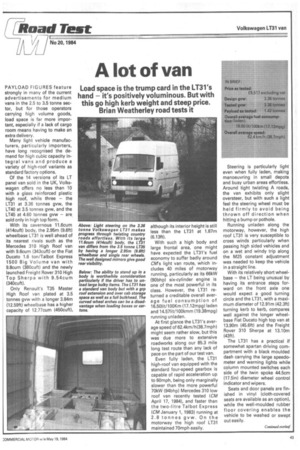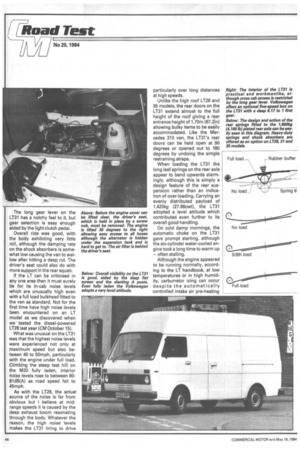A lot of van
Page 45

Page 46

Page 47

If you've noticed an error in this article please click here to report it so we can fix it.
Load space is the trump card in the LT31's hand — it's positively voluminous. But with this go high kerb weight and steep price. Brian Weatherley road tests it
PAYLOAD FIGURES feature strongly in many of the current advertisements for medium vans in the 2.5 to 3.5 tonne sector, but for those operators carrying high volume goods, load space is far more important, especially if a lack of cargo room means having to make an extra delivery.
Many light vehicle manufacturers, particularly importers, have long recognised the demand for high cubic capacity integral vans and produce a variety of high-roof variants as standard factory options.
Of the 14 versions of its LT panel van sold in the UK, Volkswagen offers no less than 10 with a glass reinforced plastic high roof, while three — the LT31 at 3.36 tonnes gvw, the LT40 at 3.5 tonnes gvw, and the LT45 at 4.60 tonnes gvw are sold only in high top form.
With its cavernous 11.6cum (414cuft) body, the 2.95m (9.61t) wheelbase LT31 is well ahead of its nearest rivals such as the Mercedes 310 High Roof van with 9.6cum (343cuft) or the Fiat Ducato 1.6 ton/Talbot Express 1 500 Big Volume van with 9.8cum (380cuft) and the newly launched Freight Rover 310 High Top Sherpa with 9.54cum (340cuft).
Only Renault's T35 Master High Roof van plated at 3.5 tonnes gvw with a longer 3.84m (12.59ft) wheelbase has a higher capacity of 12.77cum (450cuft), although its interior height is still less than the LT31 at 1.87m (6.13ft).
With such a high body and large frontal area, one might have expected the LT31's fuel economy to suffer badly around CM's light van route, which includes 40 miles of motorway running, particularly as its 66kW (90bhp) six-cylinder engine is one of the most powerful in its class. However, the LT31 returned a creditable overall average fuel consumption of 16.501it/100Km (17.12mpg) laden and 14.571it/100kmm (19.38mpg) running unladen.
At first glance the LT31's average speed of 62.4km/h(38.7mph) might seem rather slow, but this was due more to extensive roadworks along our 85.3 mile long test route than any lack of pace on the part of our test van.
Even fully laden, the LT31 high-roof van equipped with the standard four-speed gearbox is capable of rapid acceleration up to 60mph, being only marginally slower than the more powerful 70kW (94bhp) Mercedes 310 low roof van recently tested (CM April 17, 1984), and faster than the two-litre Talbot Express (CM January 1, 1983) running at 2.8 tonnes gvw. On the motorway the high roof LT31 maintained 70mph easily. Steering is particularly light even when fully laden, making manoeuvring in small depots and busy urban areas effortless. Around tight twisting A roads, the van exhibits only slight oversteer, but with such a light feel the steering wheel must be held firmly to avoid being thrown off direction when hitting a bump or pothole.
Running unladen along the motorway, however, the high roof LT31 is very susceptible to cross winds particularly when passing high sided vehicles and on a wet and windy trip along the M25 constant adjustment was needed to keep the vehicle in a straight line.
With its relatively short wheelbase — the LT being unusual by having its entrance steps forward on the front axle one would expect a good turning circle and the LT31, with a maximum diameter of 12.91m (42.3ft) turning kerb to kerb, compares well against the longer wheelbase Fiat Ducat° high top van at 13.90m (45.6ft) and the Freight Rover 310 Sherpa at 13.10m (43ft).
The LT31 has a practical if somewhat spartan driving compartment with a black moulded dash carrying the large speedometer and warning lights while column mounted switches each side of the twin spoke 44.5cm (17.5in) diameter wheel control indicator and wipers.
Seats and door panels are finished in vinyl (cloth-covered seats are available as an option), while the well-moulded rubber floor covering enables the vehicle to be washed or swept out easily. The long gear lever on the LT31 has a notchy feel to it, but gear selection is easy enough aided by the light clutch pedal.
Overall ride was good, with the body exhibiting very little roll, although the damping rate on the shock absorbers is somewhat low causing the van to wal low after hitting a deep rut. The driver's seat could also do with more support in the rear squab.
If the LT can be criticised in any one area then it must surely be for its in-cab noise levels which are unusually high even with a full load bulkhead fitted to the van as standard. Not for the first time have high noise levels been encountered on an LT model as we discovered when we tested the diesel-powered LT28 last year (CM October 15). What was unusual on the LT31 was that the highest noise levels were experienced not only at maximum speed but also be tween 40 to 50mph, particularly with the engine under full load.
Climbing the steep test hill on the M20 fully laden, interior noise levels rose to between 8081dB(A) as road speed fell to 45mph.
As with the LT28, the actual source of the noise is far from obvious but I believe at mid range speeds it is caused by the deep exhaust boom resonating through the body. Whatever the reason, the high noise levels makes the LT31 tiring to drive particularly over long distances at high speeds.
Unlike the high roof LT28 and 35 models, the rear doors on the LT31 extend almost to the full height of the roof giving a rear entrance height of 1.70m (67.2in) allowing bulky items to be easily accommodated. Like the Mercedes 310 van, the LT31's rear doors can be held open at 90 degrees or opened out to 180 degrees by undoing the simple restraining straps.
When loading the LT31 the long leaf springs on the rear axle appear to bend upwards alarmingly, although this is simply a design feature of the rear suspension rather than an indication of over-loading. Carrying an evenly distributed payload of 1,420kg (27.98cwt), the LT31 adopted a level attitude which contributed even further to its overall good handling.
On cold damp mornings, the automatic choke on the LT31 gave prompt starting, although the six-cylinder water-cooled engine took a long time to warm up — often stalling.
Although the engine appeared to be running normally, according to the LT handbook, at low temperatures or in high humidity, carburretor icing can occur despite the automatically controlled intake air pre-heating
and this can cause carburretor engines to stall when idling in the warm-up phase.
During normal driving, the LT31's brakes proved progressive and even. However, roller brake testing showed up an imbalance of 50kg (110 lb) in braking efficiency between the front wheels, which also had a lower overall efficiency than the rear axle a situation liable to cause the back of the vehicle to break away under heavy braking.
Daily checks on the LT31 can be carried out easily enough. Access to the dipstick is through a flap in the well-insulated engine cover, while the brake fluid reservoir is in the centre of the dashboard under a cover. To top up the radiator or service the engine, the driver's seat is removed for engine cover access.
Summary
With its 11.6cum (414cuft) body, the Volkswagen LT31 pro vides a practical alternative to a Luton-bodied chassis cab, and is certainly capable of returning better fuel consumption.
Plated at 3.36 tonnes gvw, the LT31 falls between the other high roof vans such as the 3.5 tonne gvw Mercedes 310 or Renault T35 Master, as well as the lighter Fiat Ducat° and Freight Rover Sherpa at 3.1 tonnes, making direct comparisons difficult.
However, its kerb weight is still relatively high at 1,820kg (35.85cwt) and may effect those operators looking for extra payload as well as high volume.
The price of £8,517 excluding vat is certainly more than any of its rivals, but as Volkswagen rightly says you do get a lot of van for your money.
























































































































